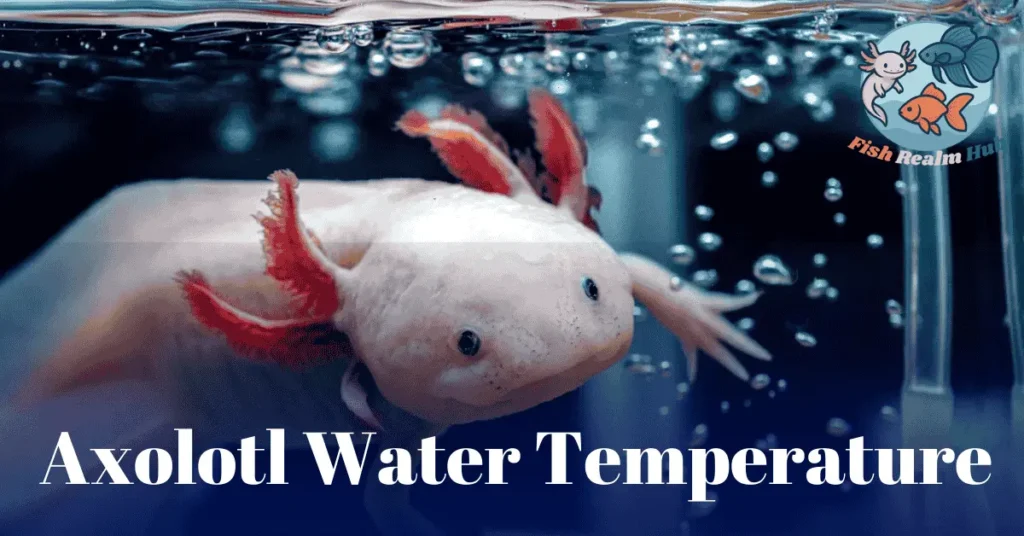Before choosing the right axolotl tank size, I spent a lot of time reading about the Axolotl tank setup, especially how important the water temperature is in creating a safe space for your axolotl. Many people underestimate this key factor when they first start caring for axolotls, and that’s why this post focuses on the most asked questions around this topic. What I came to learn is that a proper setup begins with the right space and stable temperature to keep your axolotl healthy and calm.

What’s the Best Water Temperature for an Axolotl?
In my experience, managing axolotl tank Temperature is one of the most important parts of axolotl care. In a home aquarium, the recommended temperature range to keep axolotls healthy is between 55-68F, with 64F often being the sweet spot.
Going above 75F can trigger clinical signs of stress like floating, loss of appetite, or swelling, and you may even see pale patches forming on their skin. If you live in a warmer place, explore different approaches for keeping the temperature stable and safe.
Do Axolotls Really Feel the Cold?
Unlike humans, axolotls are cold-blooded animals, so they don’t feel cold in the same way we do. Their body doesn’t try to retain heat or shiver like ours when the temperature drops. Instead, their body stays the same as the surroundings, which means any sudden changes in water temperature are the only sensations they can really detect.
From my own experience, when I noticed even a degree or two drop was detected by my axolotl’s behavior, I realized how to keep an axolotl tank cool was more important than I thought.
Their skin doesn’t react like ours, and their little nose doesn’t run—but they still rely completely on us to manage these shifts. Because they’re amphibians, everything in their tank matters more than we often realize.
What Happens When It Gets Too Cold?
In winter weather, keeping your axolotl safe means watching how cold the water gets. From my experience, it’s important to make sure the tank is deep enough so it doesn’t freeze solid, and an open area should be created at the surface for oxygen exchange if ice forms.
Axolotls are tough, but when temperatures drop below 40F for more than 20 days, it can be fatal. This is not just a small risk—when it hits freezing, even the Mexican water dragon can’t survive.
When an animal is exposed to freezing temperatures, the cells in its body begin to crystallize. These crystals can damage the internal tissues as the axolotl tries to move.
I’ve seen their blood flow and activity slow down during very cold spells, and they rely on their skin to take in oxygen. That’s why temperature changes should never happen too quickly—sudden shifts shock their system. You must monitor things closely when the cold season arrives.
The Importance of Temperature Acclimation
When it comes to axolotls, even small changes in temperature can be a big deal. A drastic drop or rise can lead to fatal outcomes because their biological systems need time to adjust. In nature, the onset of winter happens over several weeks, not overnight. But in a tank, cold or hot conditions can change suddenly, which may cause cold shock.
This happens when the animal is quickly exposed to colder water, which can affect the function of organs, slow down vital processes, and even kill the axolotl. That’s why it’s important to let your axolotl gradually adapt to new conditions.
I once received one through the mail during summer, and the final water in the bag was much warmer than my aquarium — that taught me how important acclimation is.
A better method I learned from experienced fishkeepers is drip acclimation. It helps the axolotl get used to not only the new temperature but also the chemistry differences, like ammonia, TDS, or parameters that may have changed a bit during transit.
Even though the original water they lived in might be similar, tiny shifts can cause spikes in levels. Floating the bag for at least 20 minutes also helps on a smaller scale to let them acclimate. Species like shrimp or discus are also fragile and benefit from this method.
So when bringing a new axolotl home, remember that sudden swings can stress them out and that gradual change is always better.
How Cold Water Helps Your Axolotl
Keeping axolotls in cold temperatures — especially between 50F and 32F — can actually be very beneficial, at least for a while. These cold-water animals naturally handle lower temps better than heat, which often causes stress. In fact, cold water can help buy time if your axolotl is doing poorly.
I’ve used this method myself when I noticed one of my axies acting off, and the cooler environment helped it recover. Colder water reduces the animal’s need for food, which is especially helpful if you’re wintering your pet outdoors or in a very chilly place that requires less feeding.
Another reason to consider low temperatures is how the immune system continues to function normally even when the metabolism slows down. At the same time, the reproduction of harmful pathogens like bacteria and fungus is greatly slowed, which is why some owners use fridging for mildly sick axolotls.
Some breeders even report that healthy animals grow larger when exposed to a season of winter, instead of living in constant moderate conditions year-round. From what I’ve seen, axolotls tend to thrive with seasonal changes that mimic the sources they come from in nature.
There’s even talk that colder water speeds up wound healing better than normal water. But one thing to be careful about — the biological filter in your tank stops functioning when temperatures drop below 62F. So, although feeding may be reduced, you should still monitor ammonia output, since leftover or uneaten food can become toxic.
I always make sure the tank is periodically changed, and I keep testing the water frequently — it’s a really good idea to keep your axolotl safe and healthy.
Keeping Axolotls in Outdoor Ponds
Axolotls can live in a pond as long as the water temperature stays safe — it shouldn’t get too warm in summer or freeze solid in winter. If the winter is harsh, long, or involves prolonged exposure to very cold water, it can be harmful.
From my own setup, I’ve learned that extra consideration must be given to protecting the pond from predators like birds or raccoons, especially since outdoor conditions are harder to control.
Ideal Conditions for Egg Hatching
For axolotl eggs, the recommended incubation range is around 60-72F, with the mid-sixties being a good mark for stable development. Warmer water can make them hatch faster, while cooler temps slow things down.
From my own breeding experience, I’ve seen how temperature affects not just hatching but also tolerance in young axolotls, possibly due to a connection with their early incubation temperature.
Some anecdotal reports even suggest that tropical conditions might lead to heat-tolerant axolotls, while cold environments below 50F could have the opposite effect. Still, there’s always a risk of harming the eggs if exposed to extreme temperatures.
Faqs
Are axolotls warm or cold water?
Even though axolotls come from Mexico, they are truly cold water animals. I’ve kept many over the years, and I’ve seen how important it is to stay within the optimal temperature range of 16–18°C. Since they are cold blooded, they can’t regulate their body temperature on their own, so the water must always stay in the right range.
Is 20 degrees ok for an axolotl?
For your axolotl, it’s best to keep the water temperature in the tank consistently below 20°C (68°F). While some suggested ways like using ice might help to cool the tank, they aren’t always reliable or consistent. I’ve found more effective methods that keep the temperature stable and safe for them without sudden changes.
What happens if axolotl water is too warm?
If the water temperature gets too warm, your axolotl can suffer from stress and serious health problems. The ideal range is 55–68°F (13–20°C), and anything above 75°F (24°C) becomes stressful. I’ve seen how prolonged exposure to high temperatures can even turn fatal, which is why keeping within that safe zone is so important.
Can axolotls live in 50 degree water?
No, cold water like 50°F is not ideal for axolotls because it can slow their metabolism and affect their activity. It’s best to keep the temperature between 60–68F at all times to make sure they stay healthy and comfortable.

